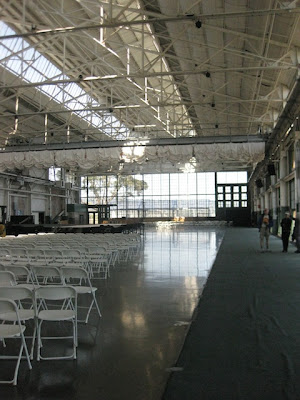 |
| (l-r) Howe, Bevir, Catlaw, Stanisevski |
PATNet is the Public Administration Theory Network. It's the faculty of public administration who have more of an abstract/philosophical bent. Someone asked if I was blogging the conference. I thought about it. This is a conference that always pushes my brain beyond the point where I usually stop. It's hard work. The panels I've been to took all my attention to catch 70 or 80% of what was being said. I need too much time to let this stuff settle to write intelligently about things as it happens. Plus, I need the breaks to talk with folks.
Right now the head of the Asia Foundation is talking about their work in Asia, which is relatively easy to listen to as I type. For now though I want to just let you know about the previous session. I got enough of my blogger mode going to take some pictures and I can tell you the paper titles.
This is the conference that kept me sane and intellectually challenged over the years. The people here pulled me into the larger issues that underlay the everyday things. I realize the titles in this panel are particularly abstract. But these are important intellectual challenges that push the boundaries of what I know and force me to question what I know. This conference is probably the basic source of the title of this blog.
Concurrent Session II, Session #2
Friday May 31, 2013
1:00 pm
Panel: “Utopias, Pluralisms, and Modes of Inquiry”
“Interpreting Governance: On Dystopian and Utopian Modes of Knowing”
Mark Bevir, University of California, Berkeley
This paper explores the relationship between forms of knowledge and utopian and dystopian visions. I offer a dystopian view of formal and technocratic knowledge: such knowledge erodes democracy and leads to policy failure, for it privileges experts and ignores the creativity of human agents. Thereafter I turn to the type of knowledge needed to sustain a humanist democracy and the scholarly and political practices associated with such knowledge. I emphasize the importance of an interpretive social science that allows properly for intentionality, historicism, and reflexivity. This interpretivism entails a more decentred approach to public administration – and approach I illustrate by considering work on policy networks and governance. Finally, the paper concludes by discussing the implications of the argument for policymaking: practitioners should adopt: an eclectic approach to data, a suspicion of formal models and frameworks, and a greater role for storytelling.
“Ontology Beyond Typology: Pluralism, Onto-theology, and Afoundationalism in Public Administration”
Thomas Catlaw, Arizona State University
Much work in social science has elaborated the ways in which the “ontological” assumptions of a paradigm, framework, or conceptual scheme are connected to the epistemological and methodological possibilities of those frameworks. Drawing on the work of Alain Badiou, this paper argues that, by and large, efforts to typologize social scientific paradigms share an underlying commitment to ontotheology, or the utopian proposition that Being is One. This paper elaborates the various ways in which this proposition is expressed and argues that this commitment retains a stumbling block to the development of an open, pluralistic approach to social science. The paper presents Badiou’s ontology of the pure multiple as an alternative way of approaching ontological questions and to rethinking the grounds for pluralism in social inquiry."
“Khōra: An Inquiry into Polytopian Philosophy”
Dragan Stanisevski, Mississippi State University
The proposed paper examines polytopian philosophy as an envisioning of plural societies (many-places) that could be both utopian (no-place) and eutopian (good-place) (Landi, 1536, in Tucker, 2003). The paper first looks at polytopia through Kristeva’s lens as a philosophy of inclusion (1977, 1984, 1993, 1994). The paper then connects polytopian philosophy to Derrida’s (1995) discussion of Plato’s khōra. Khōra is a space that is simultaneously an evading receptacle and an erasure and as such does not give an established architecture, but it allows an opportunity to deliberatively participate in the process of co-creation of polytopian narrative(s) of societies to be (Derrida and Eisenman, 1997, pp. 35-36). Polytopian philosophy enables us to think of possibilities of better societies where differences could meet again and again without imposition of ideological absolutes (see Mannheim, 1936).
Moderator/Discussant: Louis Howe, University of West Georgia
 |
| The folks listening |
Louis Howe did a great job as moderator, giving a seemingly rambling, but clearly well thought out, set of comments and reactions and questions for each presenter. He was self-deprecating and funny in the lowest key possible way. And as, he said, this was a really challenging set of papers.
I don't think I can blog too much of the conference. This is far more challenging than blogging, say, the legislature or the redistricting board.








































